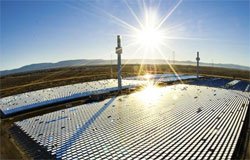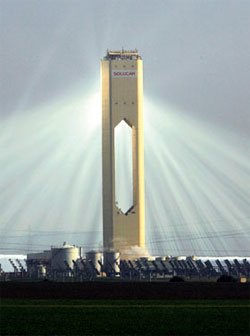Solar Energy comes to Crete

Mirrors at a thermosolar plant in Spain
Solar energy in Crete still remains unused, excluding the numerous solar water heaters on the tops of the houses. This fact is about to change soon though, with the creation of the largest thermosolar plant in Europe, at the south-eastern corner of Crete, at the Municipality of Lefki.
Municipality of Lefki is one of the smallest municipalities in Crete, with limited income, as the tourism is low and the landscape doesn’t allow much of agricultural exploitation. It is located at the most remote area of the south-eastern Crete, south of Zakros, and east from Makry Gialos. The municipality consists of areas such as Xerokambos, Ziros, Goudouras and other small villages.

This remote area in Crete was chosen for the largest investment on solar energy so far, with the creation of a thermosolar plant that will be established in Agia Triada, covering a total area of 100 hectares, generating energy of 20MW.
The international company NUR-MOH won the contest held by the Municipality of Lefki. The company will provide the Cretan network with the produced electricity and will be paying 796,000 Euros on an annual basis to the Municipality.
Except for the rent, the Municipality will be receiving the 3% of the gross income, as the law suggests. A great number of new working positions will be open, while several landscape projects are to be launched. The thermosolar plant will also operate as a park open to the public.
The Mayor of Lefki suggests that this is an investment of significant importance for the Municipality that will boost the development and utilization of natural resources. It is an investment that will enhance and make the area known, encouraging the use of eco-friendly technological solutions.
According to the signed agreement, the contractor will build and administrate the thermosolar station that will provide the area with at least 20 to 25MW. The plant will be able to concentrate the solar energy with the help of mirrors, will heat the water and will produce steam that will set in an electric generator/ tourbine in motion. The electricity will be sent to the existing network of DEI (public power corporation of Greece), who will be buying the generated energy.
This investment made by the Municipality of Lefki started as an initiative in 2006, in collaboration with the professor of the Polytechnic School in Crete, G. Stavrakakis.
Thermosolar Station in Seville Spain

This plant in Lassithi is double the size of the first European thermosolar station in Seville in Spain that produces 11MW, enough energy for 6,000 houses, which prevents the emission of 180,000 tons of carbon dioxide to the atmosphere.
The plant in Seville occupies a total area of 70 hectares (700,000 sq m) with 624 moveable mirrors, each with a surface of 120 sq m. These mirrors, called heliostats, move constantly, following the motion of the sun. They reflect the solar beams and they send them to a small boiler found on the top of a tower of 40 floors, of 114 meters height. The produced heat makes water boil and produces steam that sets the electric generators in motion.
Spain, one of the countries that depend on the import of oil and gas, presented two years ago a second project for the production of energy from renewable sources of energy, something that offers tax deduction to companies that make use of clean technology.
Until 2013 eight more plants will be constructed in Spain, with a total generation of 302MW, enough for offering clean energy to 180,000 houses. Thermosolar energy is considered more efficient than photovoltaic energy. The Abengoa group of companies has invested 35 million Euro for the first plant, an amount that is expected to get to 1,3 billion Euro for all 8 plant units.
It should also be noted that Spain is a country whose climate resembles the Greek climate a lot; it is the second country after Germany in the use of Aeolic energy, with a total of 8.155MW in 2004.